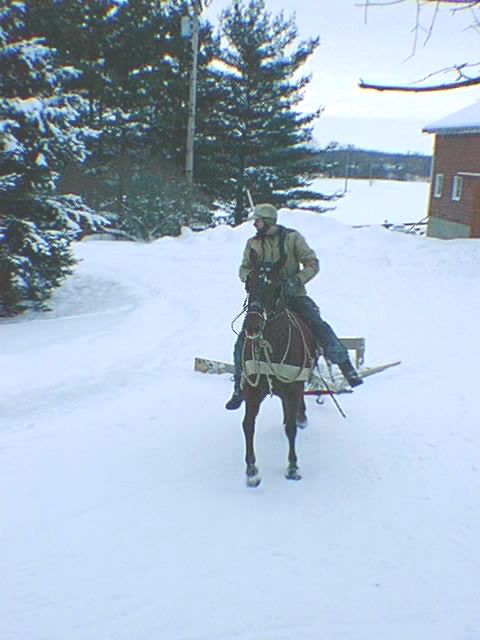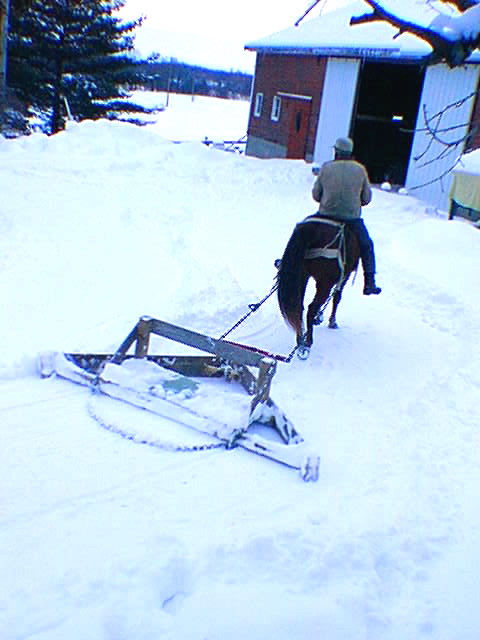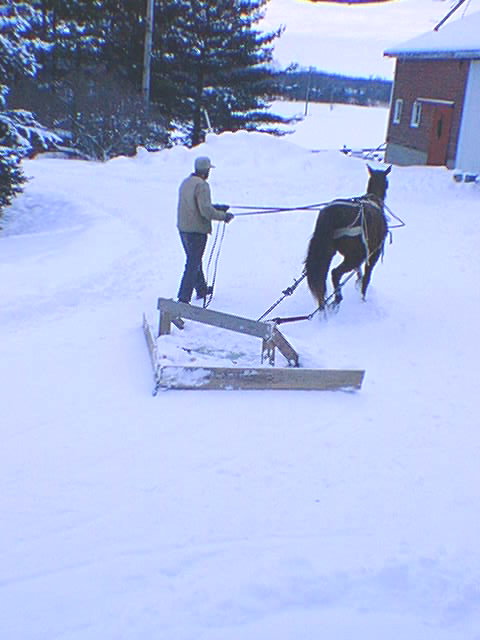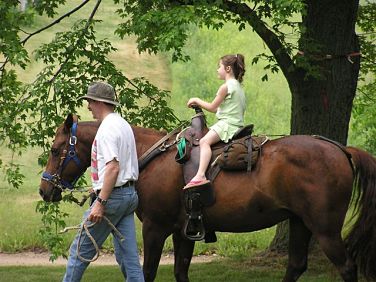One Horse-powered Snowplow

Kate, about a 1,000 pound Quarter-type mare
likes to pull the V-plow at a trot, sometimes a quite brisk trot.
She will walk if encouraged to do so but really prefers to
pull at a trot and the harder the pull the faster she
wants to go. She was originally trained (by me) to pull
a cart and a spring wagon (flat bedded open topped buggy) -
she was also trained (by me) to be a riding horse.
She was ridden around 100-150 miles "down the road" as preparation
for driving "down the road."
She then had over 500 "down the road" driving miles put on her the year she was trained.
In a nutshell this was NOT a green-broke horse
being hitched up to a snowplow (an implement it had NEVER seen) -
it was a driving horse with lots of miles over several years put on her (hauling rocks, brush, manure, plus the easy rolling jobs hauling loads of humans).


The plow point is a piece of 4"by4" as long as the plow boards
are wide. The plow boards are nailed to it with Ardox (twisted)
OR ringshank nails to form a 90 degree angle. A 1" hole was bored
through the plow boards just behind the 4"by4" point - centered - we used
a very stout rope with a hook on it as the pull point -
you could easily use chain - we just had the rope handy, were snowed in
and could not get to the hardware store to buy appropriate chain.
We then figured out how long each plow board needed to be to give
us a nine foot swath (they need to be equal in length). We used two 2"by4" boards
as bracing to keep the V open when the plow is being pulled.
The back brace is full dimension oak - we pull the plow backwards off this brace
so it needs to be appropriately stout.
These braces are nailed on through the plow boards with pole barn ring shanks.
The braces set about 2-3 inches off the ground and form a base
for a platform you can drive from if you like (harder to see though).
My son and I laid another vertical 2"by4" piece on the plow board DIRECTLY
behind the bracing (bracing for the bracing). We built a platform from scrap
lengths of 2"by6" and built a braced dashboard to hang onto
or lean against while riding or driving. When my son shot these photos
we were just finishing up the drive so we had our short horse length log
chain hooked on the back brace so we could pull the plow
in reverse to clear off the wider spots in the drive. We don't normally
drag the chain - we just hook it up when doing the final clean-up.

Up near the barn, for instance, we need to plow about a 20-30 foot swath.
So we make a couple full cut passes separated by several feet which leaves a ridge of snow in the middle that we pull off by using the plow in reverse. When the now reversed plow gets loaded up it naturally floats up - so it never gets so heavy Kate can't pull it - but if the snow is deep in the ridge you will need to make several passes to get it all cleaned off.

Of note - due to the point of pull being right on the point of the plow the point comes up a little when the pulling gets hard - while this does make for having to make a clean-up pass it also naturally keeps the horse from getting bogged down to the point of stalling out - when the load gets hard to pull the point comes up a bit and that reduces the draft and keeps the horse moving forward - when the load reduces the point settles back down and the plow again cleans up the middle of the drive better. You end up making multiple passes in deeper snow but you do get the job done.
2021 Addendum: Kate passed away at age 29-1/2 (several years ago) after serving our family well for 24 years after I trained her to be a ride/drive horse. She was given to me with the name Brandy on the promise I would not send her to the killers. You see Brandy had kicked another farrier very hard in the jaw after which that farrier would not trim her again. I met Brandy when she was 5-1/2 yrs old after a local (now retired) veterinarian recommended me to the owner knowing I was both a farrier and trainer. When she was given to me she would try to kick (with serious intent to hit and hit hard) if she was touched anywhere from her flanks on back from top to bottom. She was a super dominant minded boss mare and it took about a week of training work before I was confident she would not kick anyone while being handled. Next I worked on teaching her that my little kids were to be treated like the boss mare's foals - you do not mess around with them - you totally treat them with respect. I would be kidding you if I told you Kate was easy to train - she was not. But with much training work she became a VERY solid ride/drive horse. She underwent a process of conversion from being disrespectful to humans and thus unsafe to be around to being a horse you could trust to take care of a small child. She learned a great deal from me and I likewise learned a great deal from her. She is missed.

Jack Griffes
Certified Farrier - Colt Starting Trainer
Lenawee County, Michigan
USA
All are invited to Come unto Christ
How to teach your horse to pick up its rider from a raised mounting platform
How to teach your horse to calmly accept the electric clippers
while trimming its bridle path and pasture trimming its ears
How to teach your horse to stand
perfectly calm while
totally UNRESTRAINED
for shoeing / trimming / etc.
How to teach your horse to Stand-Stay
so it will be a better helper for you.
Start right!
Safely mounting a totally green horse for the first time.
Defusing the anti-predator responses associated with mounting a horse.
One Horse-powered Snowplow
This Site's Index Page
Accessed  times since 7 Nov 2007 9:23pm
times since 7 Nov 2007 9:23pm
(when I finally got around to adding a counter to this page - nearly a decade after we made this plow)
Updated formatting: 24 Jan 2021
One Horse-powered Snowplow

Kate, about a 1,000 pound Quarter-type mare likes to pull the V-plow at a trot, sometimes a quite brisk trot. She will walk if encouraged to do so but really prefers to pull at a trot and the harder the pull the faster she wants to go. She was originally trained (by me) to pull a cart and a spring wagon (flat bedded open topped buggy) - she was also trained (by me) to be a riding horse. She was ridden around 100-150 miles "down the road" as preparation for driving "down the road." She then had over 500 "down the road" driving miles put on her the year she was trained. In a nutshell this was NOT a green-broke horse being hitched up to a snowplow (an implement it had NEVER seen) - it was a driving horse with lots of miles over several years put on her (hauling rocks, brush, manure, plus the easy rolling jobs hauling loads of humans).


The plow point is a piece of 4"by4" as long as the plow boards are wide. The plow boards are nailed to it with Ardox (twisted) OR ringshank nails to form a 90 degree angle. A 1" hole was bored through the plow boards just behind the 4"by4" point - centered - we used a very stout rope with a hook on it as the pull point - you could easily use chain - we just had the rope handy, were snowed in and could not get to the hardware store to buy appropriate chain. We then figured out how long each plow board needed to be to give us a nine foot swath (they need to be equal in length). We used two 2"by4" boards as bracing to keep the V open when the plow is being pulled. The back brace is full dimension oak - we pull the plow backwards off this brace so it needs to be appropriately stout. These braces are nailed on through the plow boards with pole barn ring shanks. The braces set about 2-3 inches off the ground and form a base for a platform you can drive from if you like (harder to see though). My son and I laid another vertical 2"by4" piece on the plow board DIRECTLY behind the bracing (bracing for the bracing). We built a platform from scrap lengths of 2"by6" and built a braced dashboard to hang onto or lean against while riding or driving. When my son shot these photos we were just finishing up the drive so we had our short horse length log chain hooked on the back brace so we could pull the plow in reverse to clear off the wider spots in the drive. We don't normally drag the chain - we just hook it up when doing the final clean-up.

Up near the barn, for instance, we need to plow about a 20-30 foot swath. So we make a couple full cut passes separated by several feet which leaves a ridge of snow in the middle that we pull off by using the plow in reverse. When the now reversed plow gets loaded up it naturally floats up - so it never gets so heavy Kate can't pull it - but if the snow is deep in the ridge you will need to make several passes to get it all cleaned off.

Of note - due to the point of pull being right on the point of the plow the point comes up a little when the pulling gets hard - while this does make for having to make a clean-up pass it also naturally keeps the horse from getting bogged down to the point of stalling out - when the load gets hard to pull the point comes up a bit and that reduces the draft and keeps the horse moving forward - when the load reduces the point settles back down and the plow again cleans up the middle of the drive better. You end up making multiple passes in deeper snow but you do get the job done.
2021 Addendum: Kate passed away at age 29-1/2 (several years ago) after serving our family well for 24 years after I trained her to be a ride/drive horse. She was given to me with the name Brandy on the promise I would not send her to the killers. You see Brandy had kicked another farrier very hard in the jaw after which that farrier would not trim her again. I met Brandy when she was 5-1/2 yrs old after a local (now retired) veterinarian recommended me to the owner knowing I was both a farrier and trainer. When she was given to me she would try to kick (with serious intent to hit and hit hard) if she was touched anywhere from her flanks on back from top to bottom. She was a super dominant minded boss mare and it took about a week of training work before I was confident she would not kick anyone while being handled. Next I worked on teaching her that my little kids were to be treated like the boss mare's foals - you do not mess around with them - you totally treat them with respect. I would be kidding you if I told you Kate was easy to train - she was not. But with much training work she became a VERY solid ride/drive horse. She underwent a process of conversion from being disrespectful to humans and thus unsafe to be around to being a horse you could trust to take care of a small child. She learned a great deal from me and I likewise learned a great deal from her. She is missed.

Jack Griffes
Certified Farrier - Colt Starting Trainer
Lenawee County, Michigan
USA
All are invited to Come unto Christ
How to teach your horse to pick up its rider from a raised mounting platform
How to teach your horse to calmly accept the electric clippers while trimming its bridle path and pasture trimming its ears
How to teach your horse to stand perfectly calm while totally UNRESTRAINED for shoeing / trimming / etc.
How to teach your horse to Stand-Stay so it will be a better helper for you.
Start right! Safely mounting a totally green horse for the first time.
Defusing the anti-predator responses associated with mounting a horse.
One Horse-powered Snowplow
This Site's Index Page
Accessed
(when I finally got around to adding a counter to this page - nearly a decade after we made this plow)
Updated formatting: 24 Jan 2021